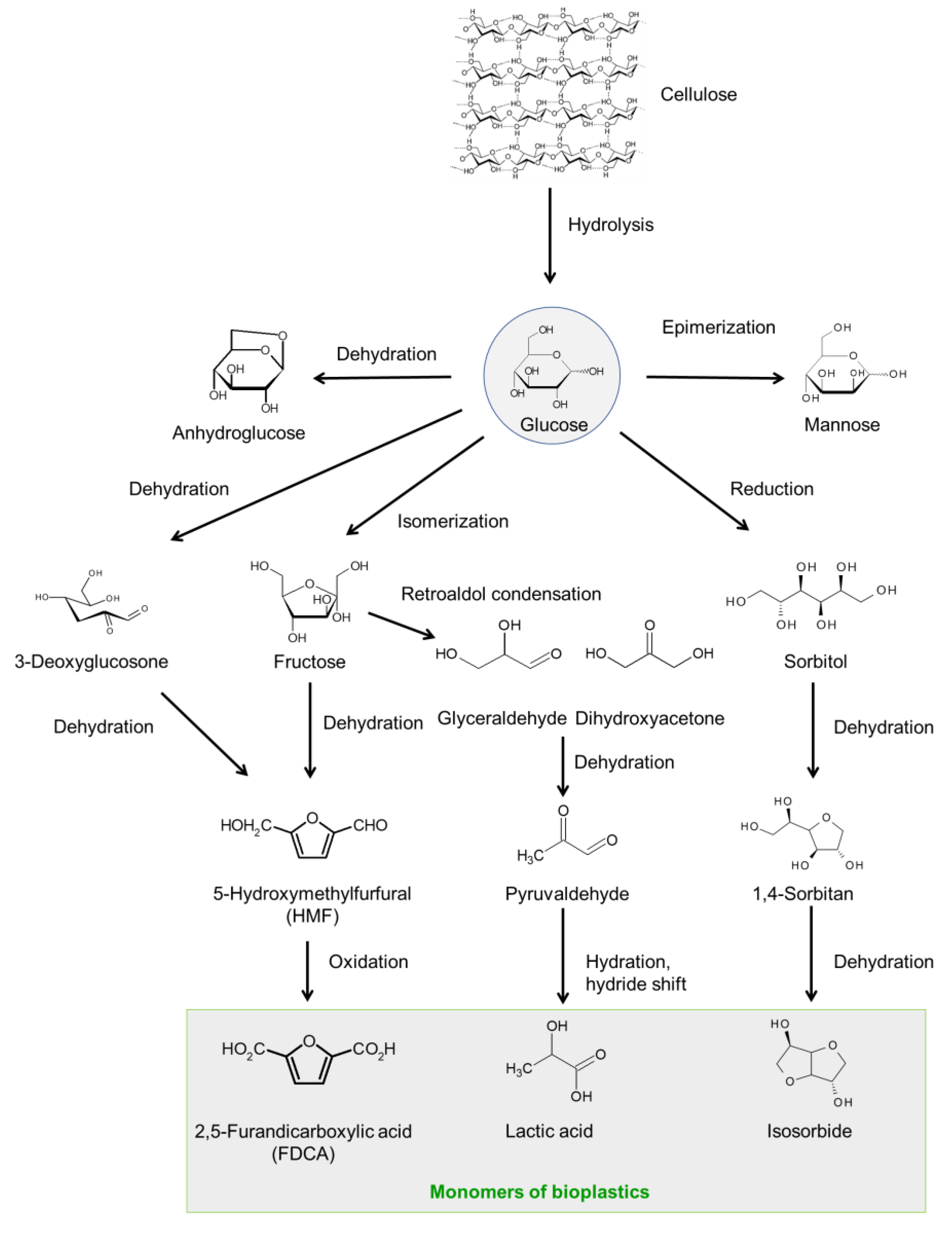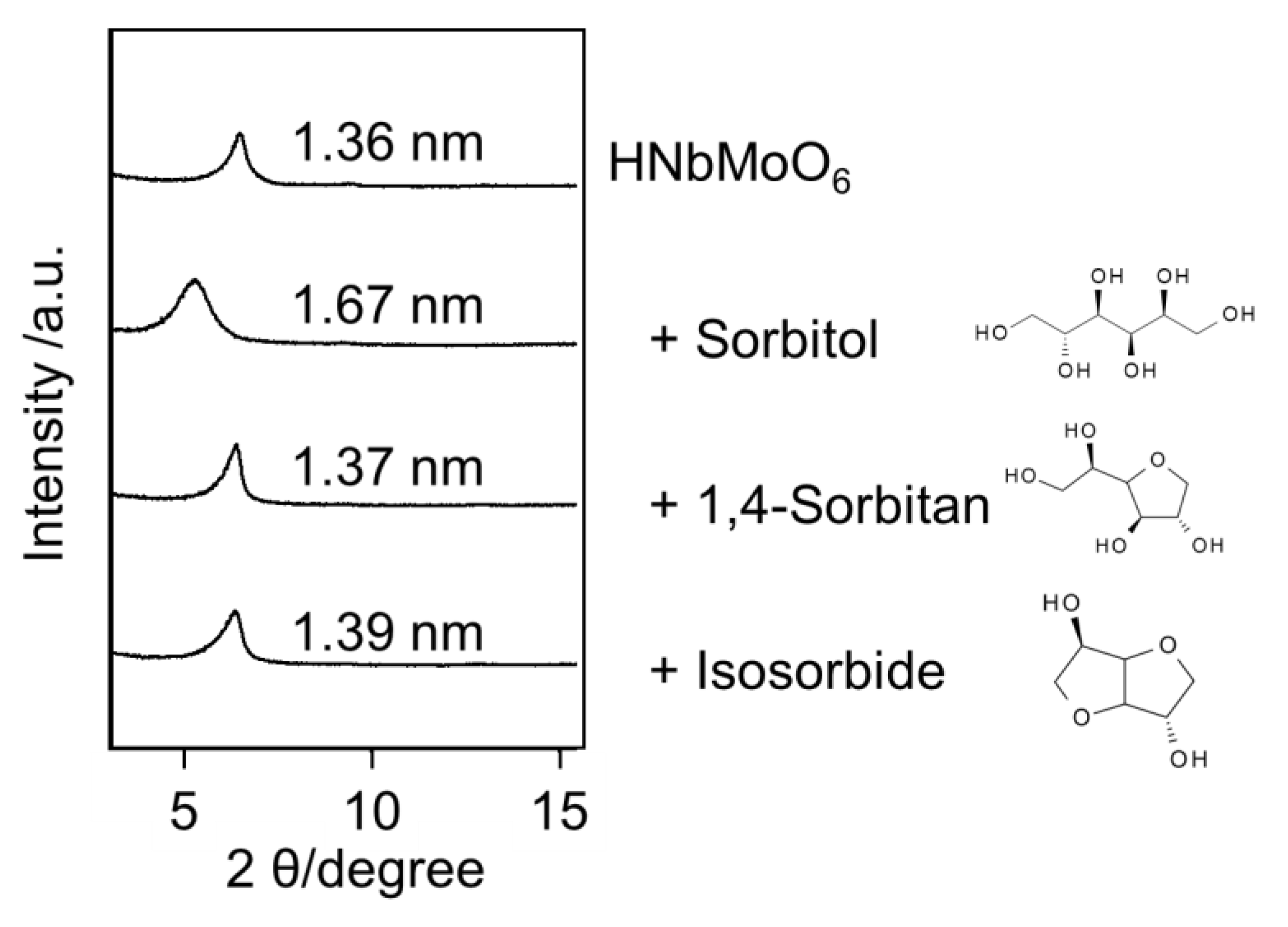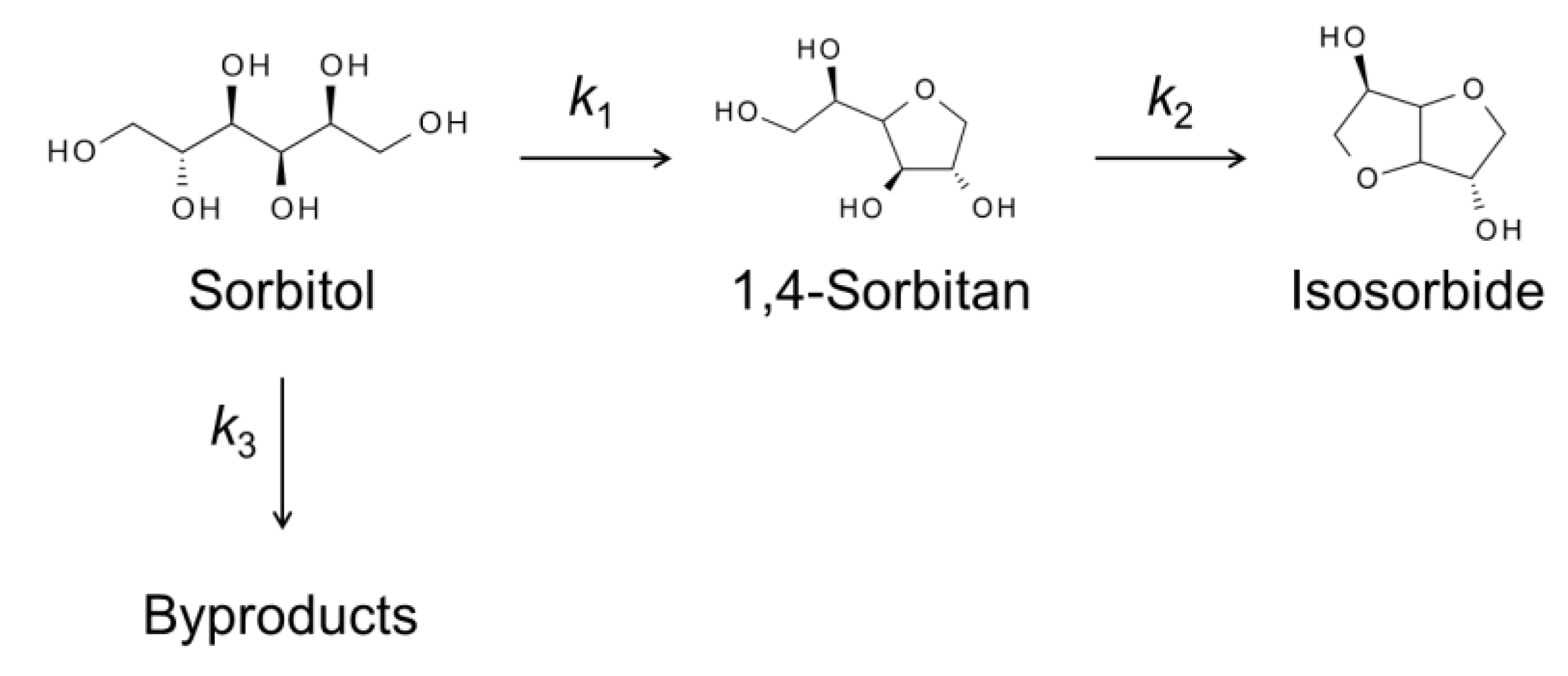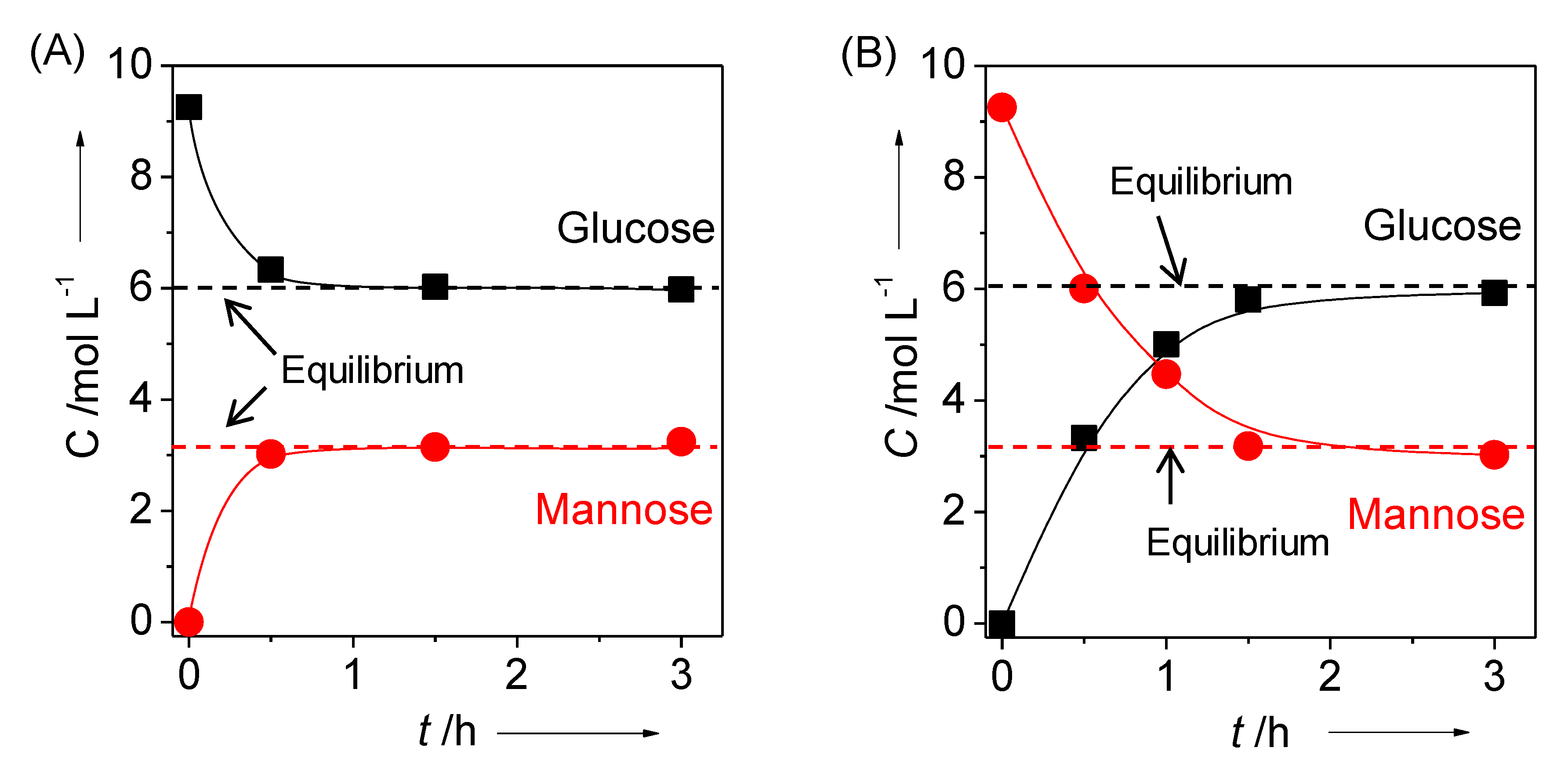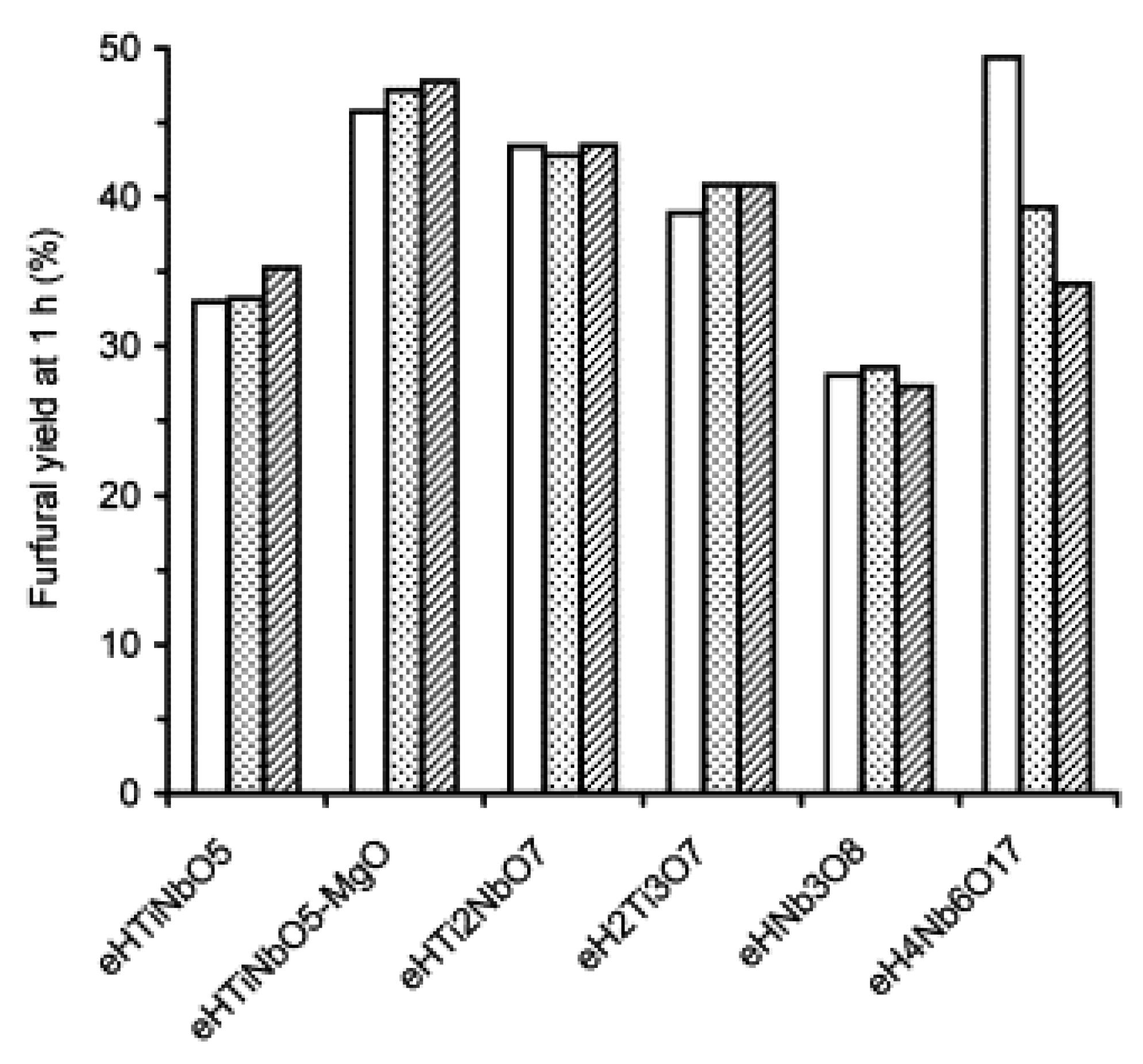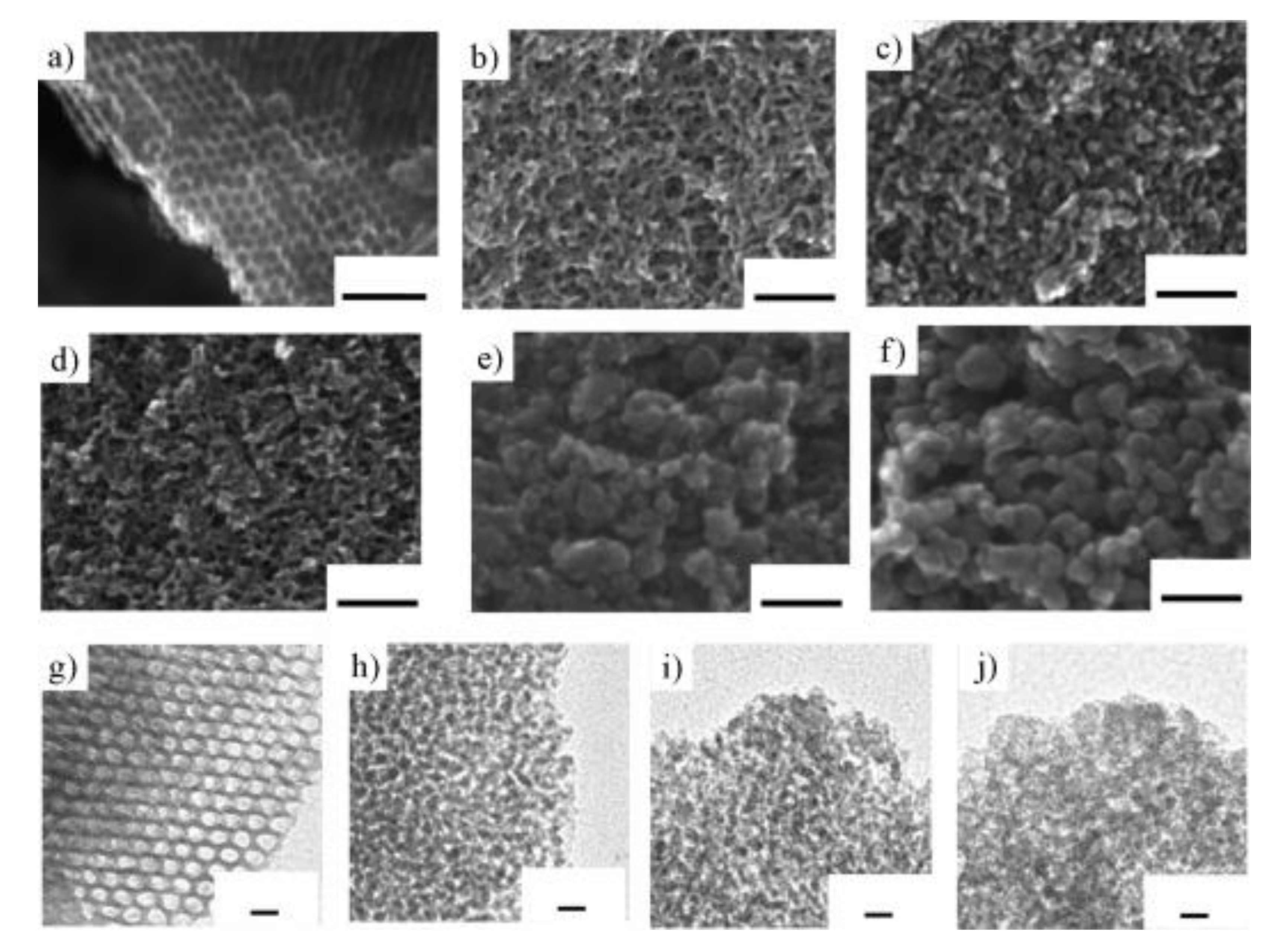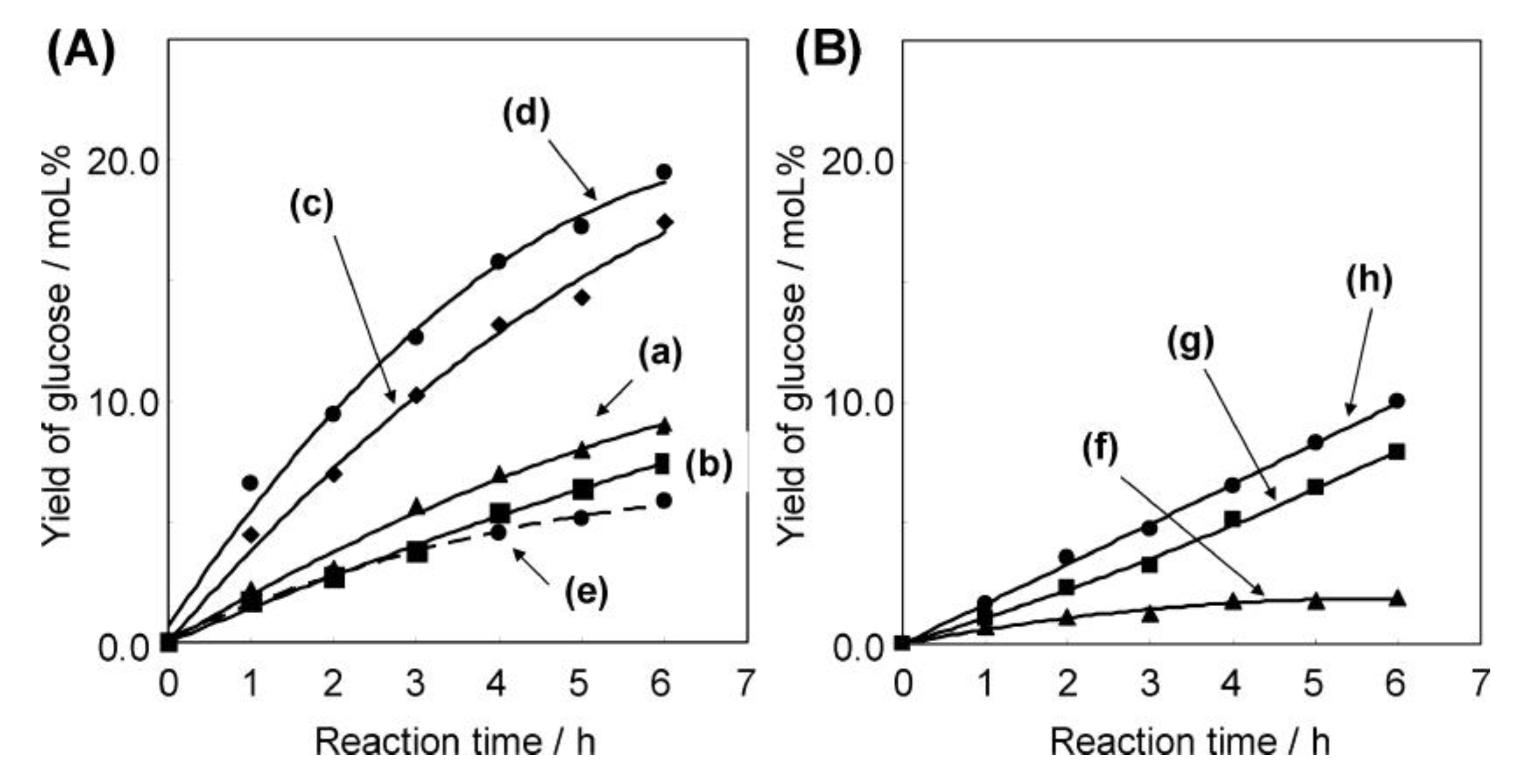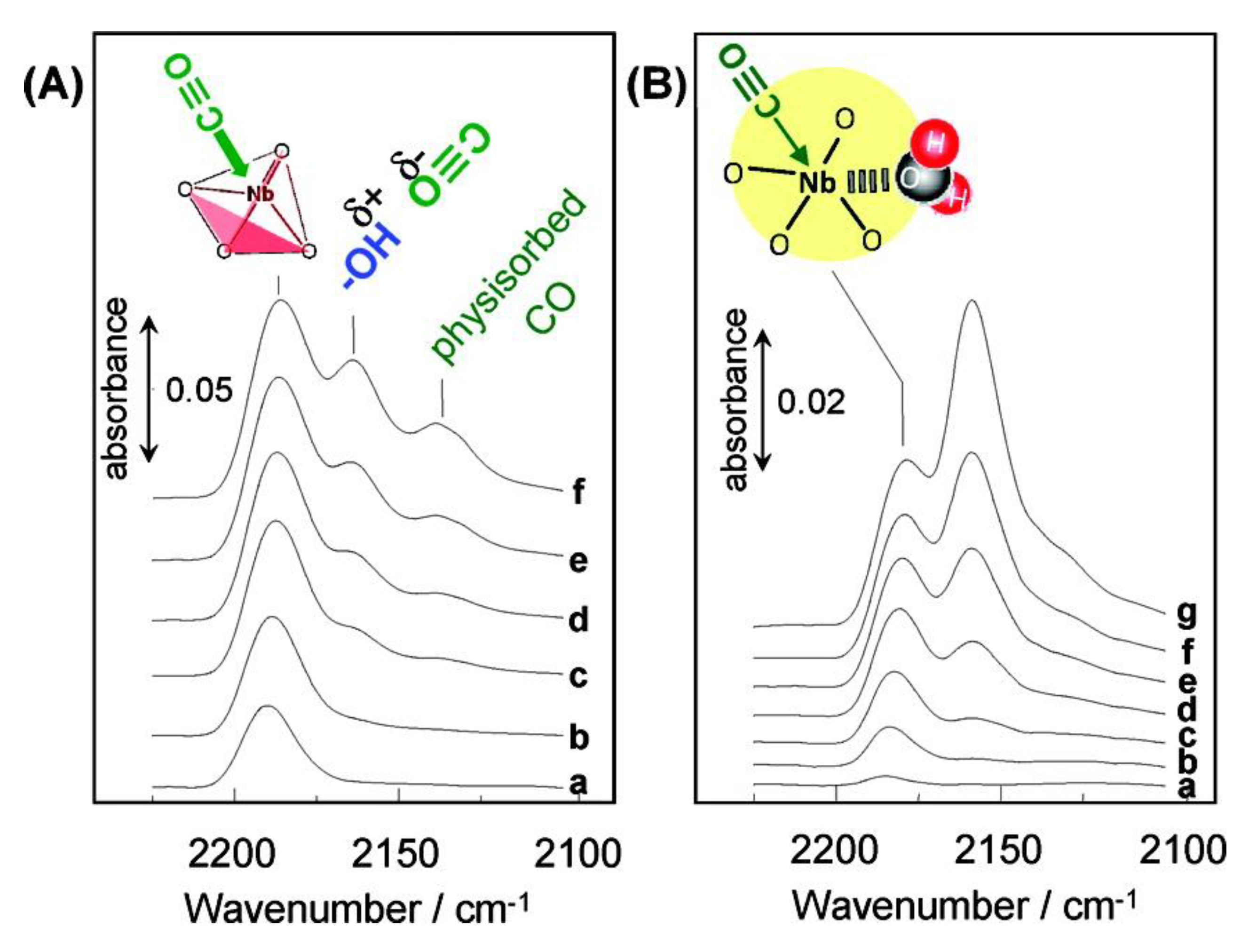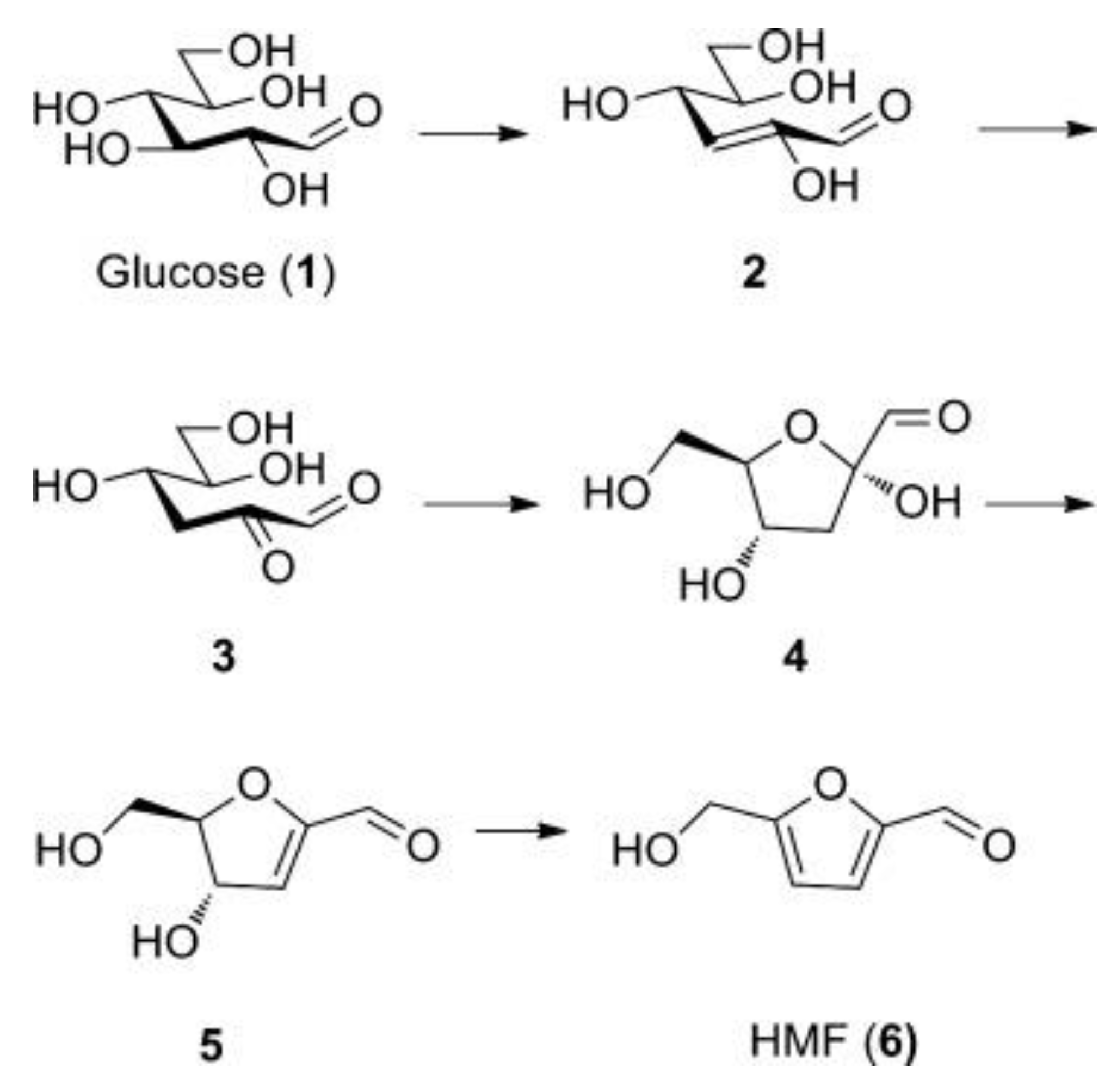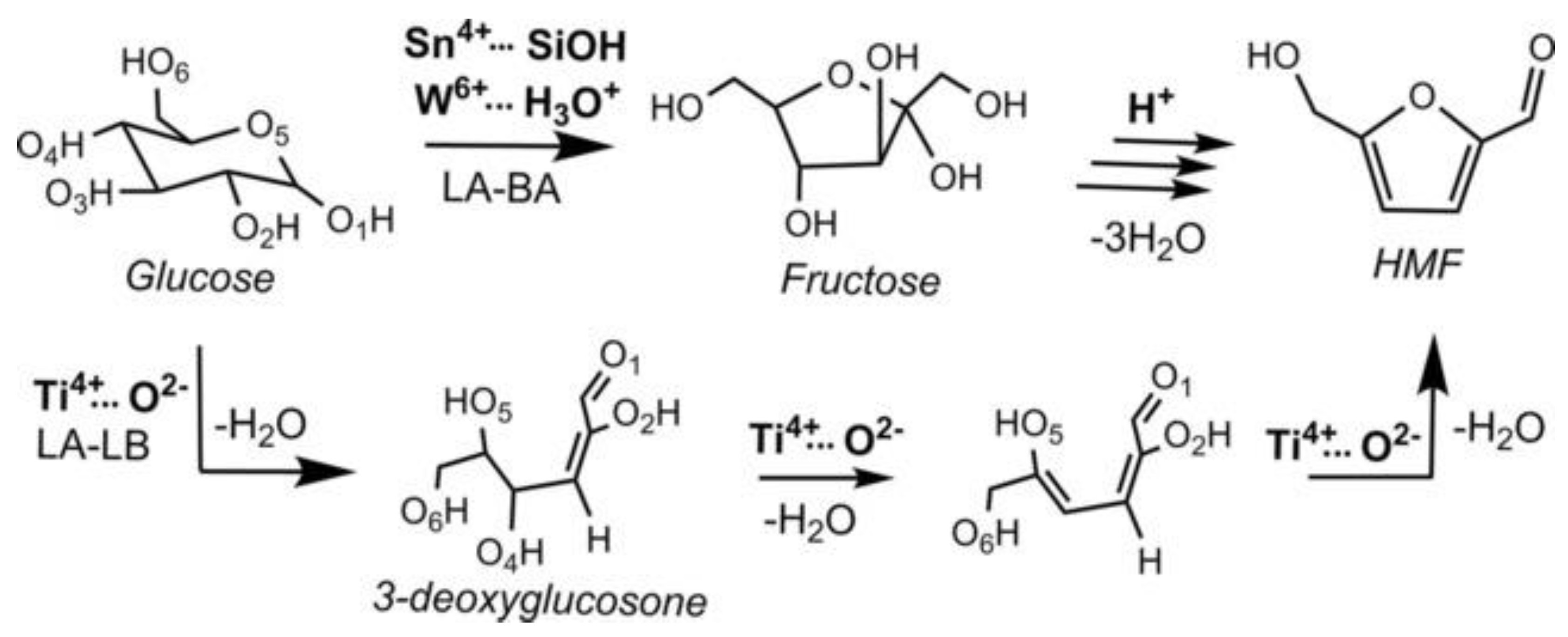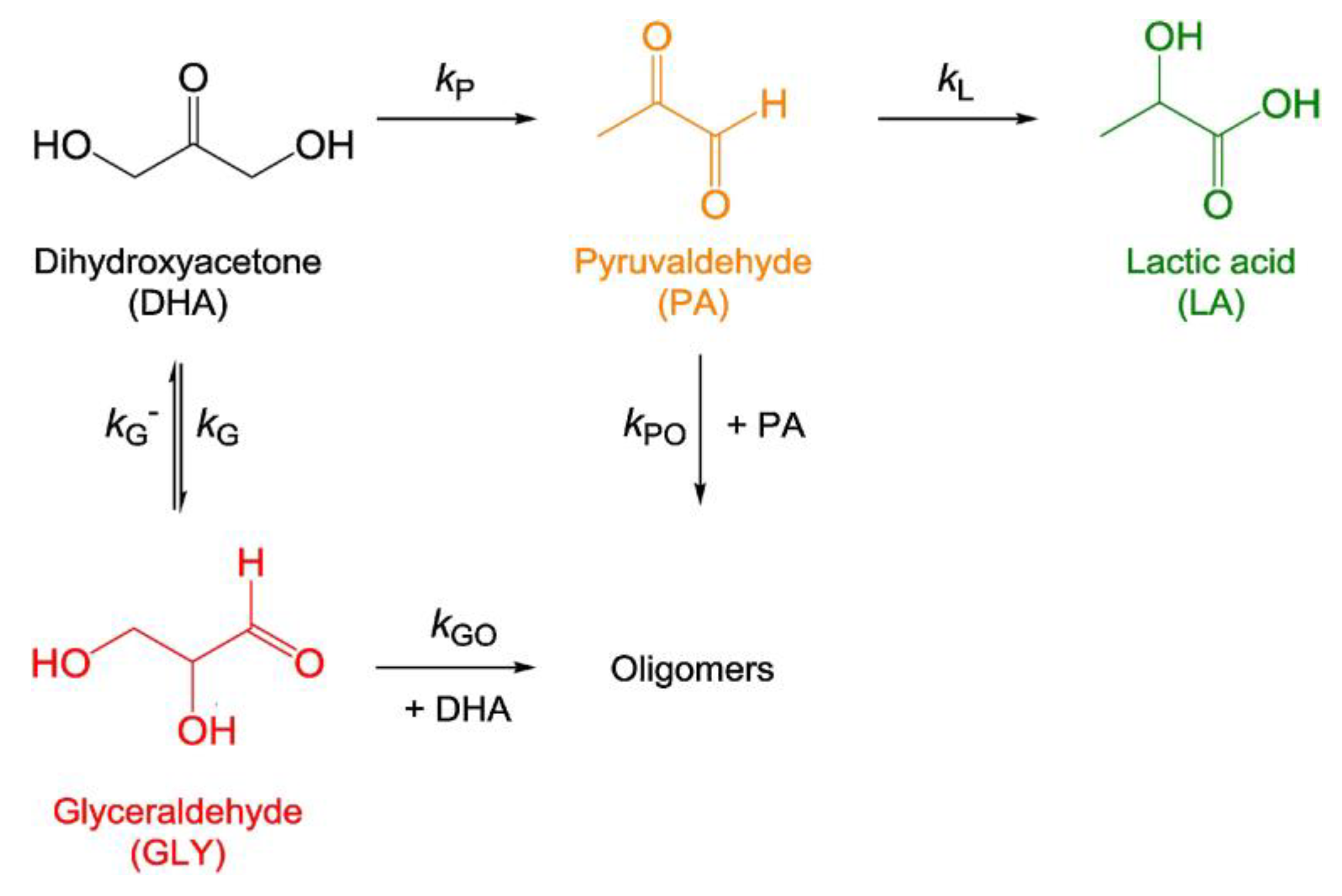1. Introduction
The fundamental features of solid acid catalysts are the reusability of the catalysts, their easy separation from the products and solvents and unnecessary neutralization, which are beneficial to saving energy and cost. Besides these, special requirements of the catalysts for sugar conversion are high recognition ability of sugar molecules and high tolerance against water.
Sugars have complex structures with many functional groups, including carbonyl and hydroxyl groups. The change in positions of these functional groups offers different characteristics such as chemical reactivity and biological activity. Sugars are highly reactive and easily degraded; thus, many side reactions could occur, resulting in poor selectivity for the desired product in most cases. A suitable catalyst should interact with a specific position of the reactant.
Sugars have many hydroxyl groups and thus are soluble in water. For the conversion of sugars, polar solvents such as water, methanol, ethanol,
N,
N-dimethylformamide (DMF) and dimethyl sulfoxide (DMSO) are widely used. Among polar solvents, water is the most suitable solvent because these sugars can be obtained from cellulose and hemicellulose via hydrolysis in water and water itself is the green solvent [
1]. However, water is not preferable for solid acid catalysts due to the following reasons. First, water molecules cover acid sites resulting in severe decrease in the catalytic activity which is typical for H-type zeolites. Second, water molecules generally cause loss of the Lewis acidity of solid catalysts. Third, water molecules may change or disrupt the crystal structure of solid catalysts due to their high polarity. For example, γ-Al
2O
3 alters its crystal structure into boehmite AlO(OH) in hot water (above 423 K) [
2].
Conventional solid acid catalysts, including zeolites, were mostly developed for oil refining in the last century. Reactants have less functional groups with non-polarity and are converted in gas-phase flow systems. These reaction conditions are very different from those of sugar conversion in the liquid phase. Before the development of solid acid catalysts for liquid-phase biomass conversion, water-tolerant solid acids were studied because reactions such as olefin hydration and ester hydrolysis necessitate water as a solvent in the petrochemical process and the importance of water as a solvent has been raised from the viewpoint of green chemistry [
3]. As water-tolerant solid acid catalysts, hydrophobic zeolites [
4,
5], solid heteropolyacids such as Cs
2.5H
0.5PW
12O
40 [
6], metal oxides including amorphous niobium oxide (Nb
2O
5·
nH
2O) [
7,
8], MoO
3-ZrO
2 [
9] and metal phosphates including niobium phosphate [
10] have been reported. Some of these water-tolerant solid acids are applicable for aqueous-phase sugar conversion. It should be noted that
d-glucose formation from maltose hydrolysis using Cs
2.5H
0.5PW
12O
40 [
11] and HMF formation from fructose dehydration using niobium phosphate [
10] were already studied before the rapid growth of researches for biomass conversion using heterogeneous catalysts from 2006. In this review,
d-glucose which is naturally obtained is simply described as glucose.
A variety of metal oxide solid acids was developed and applied for sugar conversions. The catalytic performance is mainly dependent on the types of solid acids. Amorphous metal oxides possess unsaturated metal cations that function as Lewis acid sites while some crystal metal oxides such as heteropoly acids and layered metal oxides have Brønsted acid sites. Moreover, the acid strength can be controlled by choosing adequate component elements. Furthermore, the coexistence of Brønsted acid and Lewis acid sites can be realized on the surface of the oxide. These features have significant advantages for sugar conversions.
2. Sugar Conversion
The utilization of lignocellulosic biomass has attracted much attention because it is widely available, inedible and inexpensive. Lignocellulose consists of cellulose, hemicellulose and lignin. Cellulose is the most abundant natural biopolymer with rigid crystal structure which is composed of glucose units connected by the β-glycosidic bond along with the intramolecular hydrogen bond in three-dimensional fashion.
Figure 1 shows a representative scheme for the conversion of cellulose-based biomass toward useful chemicals. Depolymerization of cellulose to glucose or water-soluble oligomers is the first step for aqueous-phase sugar conversion. Glucose is a starting material for a variety of key intermediates. Isomerization of glucose gives fructose, while epimerization affords mannose. Dehydration of glucose forms anhydroglucose (levoglucosan) and levoglucosone. Fructose and levoglucosone are currently considered to be intermediate for HMF, which is obtained by dehydration of them.
Production of HMF is very important because it can be further transformed into 2,5-diformylfuran (DFF) and 2,5-furandicarboxylic acid (FDCA) via selective oxidation, which is the corresponding dialdehyde and dicarboxylic acid, respectively. The latter is particularly important because it can be an alternative to terephthalic acid from the viewpoint of the chemical structure. Thus FDCA has a high possibility as a precursor of biomass-based plastics, which will be widely used like polyethylene terephthalate (PET).
Glucose is classified as hexose (C6 sugar) and undergoes decomposition into trioses (C3 sugar), including glyceraldehyde and dihydroxyacetone via retroaldol condensation. These trioses are further converted into pyruvaldehyde, followed by lactic acid. Lactic acid is a precursor of polylactic acid which is a well-known biodegradable polymer.
The reduction of glucose gives sorbitol, which can be further converted into 1,4-sorbitan and isosorbide via cyclodehydration. Isosorbide is also an attractive precursor for synthesis of biomass-based polycarbonate, which has been commercialized.
For the conversion of cellulose-based biomass into value-added chemicals, many reactions are catalyzed by acid, including hydrolysis, dehydration, isomerization and retroaldol condensation. Here several types of metal oxide solid acids for sugar conversions will be introduced.
3. Layered Metal Oxides
Protonated layered niobium molybdate and tantalum molybdate, HNbMoO
6 and HTaMoO
6, function as solid acid catalysts, whereas other layered metal oxides such as HTiNbO
5 and HNbWO
6 do not work because reactants cannot enter the interlayers [
12,
13,
14,
15,
16,
17,
18,
19,
20]. The characteristics of layered HNbMoO
6 and HTaMoO
6 as solid acid catalysts are their unique ability of intercalation of reactants within the interlayers with strong Brønsted acid sites and high tolerance against water. The layered metal oxides consist of negatively charged [NbMoO
6]
− or [TaMoO
6]
− layers and positively charged H
+. The proton between layers has strong Brønsted acidity, which is comparable to the strongest sites of H-ZSM5 zeolite [
12,
14]. A variety of reactants such as alcohols, aldehydes and hydroxy acids can be intercalated into the interlayers with strong acid sites, resulting in the high performance for acid-catalyzed reactions including Friedel-Crafts alkylation, acetalization, esterification, hydrolysis and hydration. The importance of intercalation for Friedel-Crafts alkylation of benzyl alcohol with anisole was confirmed by measurements of the interlayer distances of HNbMoO
6 by X-ray diffraction (XRD) [
12]. When the layered HNbMoO
6 was immersed in benzyl alcohol solution, the interlayer distance of the layered HNbMoO
6 increased due to the intercalation of the alcohol in which the total expansion was 0.55 nm. The benzyl alcohol-intercalated HNbMoO
6 could react with anisole at 373 K to produce the alkylated compounds. After the reaction, the interlayer distance decreased back. Moreover, the expansion of the interlayer distance was observed for the sample which was taken during the Friedel-Crafts alkylation. These results demonstrate that the interlayer sites of the layered oxide catalyst function as the active sites. The catalyst could apply for sugar conversion, including hydrolysis of sugars, cyclodehydration of sugar alcohols, epimerization of aldoses and mechanochemical decomposition of cellulose (
Figure 2).
Since sugars and sugar alcohols have many hydroxyl groups, these compounds could be intercalated into the layered oxides and reacted with the acid sites of the layered oxides [
13,
16,
17]. Disaccharides including cellobiose (a dimer of two glucose molecules connected by β-(1,4)-glycosidic bond) and sucrose (a dimer of glucose and fructose connected by α,β-(1,2)-glycosidic bond) are water-soluble and able to be intercalated into the oxides, led to be hydrolyzed into corresponding monosaccharides.
Figure 3 shows the results of the hydrolysis of sugars by using a variety of solid acids. The HNbMoO
6 exhibited remarkable reaction rates and turnover frequencies. For sucrose hydrolysis, reaction rate of HNbMoO
6 was ca. four times higher than that of Amberlyst-15 catalyst. For cellobiose hydrolysis, turnover frequency of HNbMoO
6 was ca. six times higher than that of Amberlyst-15. As mentioned above, H-type zeolites were difficult to use as Brønsted acid catalysts in water, resulting in negligible activity. Under these reaction conditions, no formation of glucose was observed in the absence of catalyst. The intercalation of sugars such as glucose, fructose, sucrose and cellobiose was confirmed by the expansion of the interlayer distance of the layered oxides.
Like sugars, sugar alcohols are also able to be intercalated into the HNbMoO
6 catalyst. Sorbitol, sugar alcohol obtained by reduction of glucose, could be transformed into isosorbide by cyclodehydration. The transformation of sorbitol into isosorbide is a successive reaction via the formation of 1,4-sorbitol as an intermediate. Two consecutive 1,4-cyclodehydration reactions are necessary to afford isosorbide selectively. Other cyclodehydrations occur to form undesirable products such as 2,5-sorbitan and 1,5-sorbitan. Thus, the catalyst should highly recognize hydroxyl groups of sorbitol in order to obtain 1,4-sorbitan and isosorbide selectively. Water is a desirable solvent because it is so-called green solvent and monosaccharides were formed by aqueous-phase hydrolysis of oligomers. The HNbMoO
6 catalyst could give 1,4-sorbitan from sorbitol in water [
18]. The selectivity to 1,4-sorbitan was 57% at the sorbitol conversion of 59%. While the catalyst is not suitable for the production of isosorbide, which is useful for bio-based plastics, the high selectivity to 1,4-sorbitan is of significance from the viewpoint of fundamental chemistry because 1,4-sorbitan is an intermediate between two similar 1,4-cyclodehydration reactions. The selective formation of 1,4-sorbitan over HNbMoO
6 was due to its selective intercalation. The layered HNbMoO
6 was immersed in water containing sorbitol, 1,4-sorbitan or isosorbide, separately. After filtration and drying, XRD of the layered oxide was measured (
Figure 4). The increase in the interlayer distance was found only for sorbitol. Thus, only sorbitol could be intercalated, whereas 1,4-sorbitan and isosorbide did not intercalate. Due to the selective intercalation, sorbitol could be converted into 1,4-sorbitan, but 1,4-sorbitan was difficult to make react with the acid sites of the layered oxide.
Scheme 1 shows simplified reaction pathways for sorbitol cyclodehydration over HNbMoO
6. Reaction rate constants of each reaction pathway were estimated by a kinetic study. The rate constant for the reaction from sorbitol to 1,4-sorbitan (
k1) was two times higher than that for the reaction from 1,4-sorbitan to isosorbide (
k2) over the HNbMoO
6 catalyst. Besides, the preexponential factor for the first reaction is significantly higher than that for the second reaction. These results clearly show that the selective intercalation of reactants could control the successive reaction and produce an intermediate selectively.
Like sorbitol, erythritol, C4 sugar alcohol could be dehydrated into 1,4-anhydroerythritol. Moreover, 1,4-butanediol was converted into tetrahydrofuran (THF) via the same 1,4-cyclodehydration. The HNbMoO
6 catalyst exhibited moderate activity for 1,4-butanediol cyclodehydration, while it showed high activity for erythritol cyclodehydration [
19]. Kinetic study on these cyclodehydration reactions over HNbMoO
6 indicated that the difference of the activity between two C4 diols could be ascribed to different mobility of the activated complex based on the transition state theory. The pre-exponential factor after appropriate treatment is related to partition functions involving the contribution of 3D translation, 2D translation and 1D translation. The careful calculation indicated that the activated complex for 1,4-butanediol cyclodehydration is immobile, resulting in moderate activity (
Figure 5). In contrast, the transition state for erythritol cyclodehydration is 2D translation, affording high activity. The ease of intercalation of reactants significantly affects the acid-catalyzed reaction.
As described above, the intercalation of reactants within the interlayer with strong Brønsted acid sites is characteristic of the layered HNbMoO
6. In other words, cellulose depolymerization over HNbMoO
6 was difficult because cellulose is a big molecule and insoluble in water [
13]. In these regards, the mechanochemical reaction as a different methodology was adopted for cellulose depolymerization [
20]. It has been reported that ball-milling of crystalline cellulose in the presence of acidic kaolinite, a layered clay mineral could depolymerize it and the solid acidity of additives is important to accelerate the reaction [
21]. The ball-milling of cellulose with layered HNbMoO
6 could produce a high yield of water-soluble sugars (72%) at full cellulose conversion without adding external heat, whereas the ball-milling of cellulose in the absence of catalyst afforded negligible yield of sugars (<1%) [
20]. Not only cello-oligomers such as cellobiose and cellotriose but also corresponding anhydro-sugars were produced by the mechanochemical reaction under dry conditions. The product distribution of water-soluble sugars showed that proportions of monosaccharides, disaccharides and other cello-oligomers from cellotriose to cellohexose were almost the same regardless of reaction time, whereas the total sugar yields monotonically increased (
Figure 6). These results indicate that cellulose was randomly and directly decomposed into water-soluble sugars. The addition of a small amount of water improved the sugar yields and the selectivity of sugars/anhydrosugars was increased. The motion of balls was simulated by using a discrete element method (DEM) and then the mechanical energy was calculated. It was suggested that 0.02% of mechanical energy was applied for the cleavage of glycosidic bonds. Further improvement of the energy efficiency would be possible by scaling up the apparatus.
Another feature of the layered NbMo oxide is that it could efficiently catalyze the epimerization of aldoses [
22]. Epimerization involves carbon–carbon rearrangement and is useful for the production of rare sugars. In the presence of HNbMoO
6 or LiNbMoO
6, glucose was quickly converted into mannose via epimerization (
Figure 7). An ancient study demonstrated that MoO
3 and homogeneous Mo complex could epimerize glucose to mannose, which was known as the Bilik reaction. Both HNbMoO
6 and LiNbMoO
6 could convert aldoses to the corresponding epimers (glucose to mannose, xylose to lyxose, arabinose to ribose) selectively. While MoO
3 was completely dissolved in water during the reaction, these layered NbMo oxides were insoluble and could be reused without loss of activity. The active sites for the epimerization were considered to be the Mo octahedra at the surface, not the Mo octahedra within the interlayer. The turnover frequency for glucose epimerization over LiNbMoO
6 was of significance, 1.1 s
−1 at 393 K, higher than that over Mo-based polyoxometalates. The combination of hydrolysis and epimerization over layered HNbMoO
6 realized one-pot formation of mannose from cellobiose. Amberlyst-15, a representative Brønsted acid resin catalyst could hydrolyze cellobiose into glucose, but mannose was not formed. In contrast, HNbMoO
6 also could hydrolyze cellobiose into glucose within the interlayer, and then mannose was obtained via epimerization.
4. Metal Oxide Nanosheet Aggregates
Protonated layered transition metal oxides have strong acid sites within the interlayer. However, most of the reactants cannot enter the interlayer spaces of these layered oxides except for HNbMoO
6 and HTaMoO
6. In order to overcome the drawbacks, a variety of protonated metal oxides, including HTiNbO
5, HTi
2NbO
7, HNb
3O
8, HNbWO
6 and HTaWO
6 were utilized as solid acid catalysts by exfoliating them into the corresponding two-dimensional nanosheets [
23,
24,
25,
26,
27].
Figure 8 shows the schematic crystal structure of metal oxide nanosheets.
Figure 9 shows the preparation procedure of the metal oxide nanosheet aggregates. The addition of tetrabutylammonium hydroxide (TBAOH) into aqueous solution containing powder of protonated layered metal oxide could exfoliate the layered oxide because cationic TBA
+ can penetrate the interlayers by ion-exchange reaction and the bulky TBA
+ can peel the layered oxide down to the nanosheets. As a result, a colloidal solution containing exfoliated nanosheets was obtained in which exfoliated nanosheets were negatively charged and TBA cation surrounded the nanosheets. For the application of the nanosheets as solid acid catalysts, the exfoliated nanosheets should be solidified. The addition of H
+, such as HNO
3, HCl and H
2SO
4 collapsed the stability of the colloid, resulting in the rapid formation of nanosheet aggregates.
The nanosheet aggregates had large surface areas and had Brønsted acid sites because proton was on the surface as counter ions. The solid acid properties of the nanosheet aggregates were evaluated by solid-state nuclear magnetic resonance (NMR) spectroscopy and temperature-programmed desorption of ammonia (NH
3-TPD). NH
3-TPD is a conventional method to estimate acid strength and acid amounts of solids. However, careful consideration is required when the method was applied for the metal oxide nanosheet aggregates because the nanosheet aggregates may change their crystal structures while raising temperature. Trimethylphosphine oxide (TMPO) was widely used as a probe molecule of
31P magic angle spinning (MAS) NMR for investigating Brønsted acid strength [
28]. The interaction of TMPO with Brønsted acid sites of the solid catalyst gives protonated TMPO (TMPOH
+). This species shows
31P chemical shifts at higher ppm than crystalline TMPO. Thus, the chemical shifts of TMPO adsorbed correspond to the acid strength of solid acids. The
31P MAS NMR measurements using TMPO as a probe molecule indicated that the acid strength of transition metal oxide nanosheet aggregates dramatically depends on the constituent element compositions, in the order of HTiNbO
5 < HNb
3O
8 < HNbWO
6 < HTaWO
6 (
Figure 10) [
26].
These nanosheet aggregates have so far been applied for hydrolysis of disaccharides [
13], furfural formation from xylose [
29] and HMF formation from fructose and glucose [
30,
31]. HTiNbO
5 nanosheets had a high surface areas of ca. 150 m
2 g
−1 with an acid amount of 0.4 mmol g
−1 and exhibited the catalytic activity for hydrolysis of sucrose, higher turnover frequency than Nafion NR50, Amberlyst-15, Nb
2O
5 nH
2O, H-ZSM5 and liquid H
2SO
4. The acid strength of HTiNbO
5 nanosheets was moderate, resulting in low activity for hydrolysis of cellobiose, which needs strong acids for cleavage of the 1,4-β-glycosidic bond (
Figure 3) [
13].
A variety of metal oxide nanosheet aggregates, including HTiNbO
5, HTi
2NbO
7, H
2Ti
3O
7, HNb
3O
8 and H
4Nb
6O
17, were tested for furfural formation from xylose in water-toluene biphasic solution at 433 K [
29]. A high furfural yield of 55% with a xylose conversion of 92% was obtained over HTiNbO
5 nanosheet aggregates, which were prepared by addition of MgO during the aggregation process. There was a correlation between the initial catalytic activities of the nanosheet aggregates and the total amount of Brønsted and Lewis acid sites. These titanoniobate nanosheet aggregates were reusable for the reaction (
Figure 11).
HMF formation from fructose and glucose in water was demonstrated using layered HNb
3O
8 under microwave irradiation [
30]. The layered HNb
3O
8 was exfoliated during the reaction with fructose under microwave irradiation, affording HMF yield of 56% at 423 K. The exfoliated HNb
3O
8 nanosheets were restacked after the reaction. Thus the catalyst showed reusability.
Very recently, it was reported that three acidic nanosheet aggregates, including HTiNbO
5, HNb
3O
8 and HNbWO
6 were applied for aqueous-phase glucose conversion to HMF [
31]. The activity was in the order of HTiNbO
5 < HNb
3O
8 < HNbWO
6, which is in good agreement with the order of their acidity. HNbWO
6 nanosheet aggregates exhibited high HMF selectivity of 52% with glucose conversion of 71% in a water-toluene biphasic system. It should be noted that the formation of HMF from glucose was higher than that from fructose over HNbWO
6 nanosheet aggregates. A kinetic study suggested that not only fructose but also another intermediate, possibly 3-deoxyglucosone, was involved in the reaction (
Scheme 2). When 3-deoxyglucosone and fructose were used as reactants, the selectivity to HMF from 3-deoxyglucosone was much higher than that from fructose.
6. Mesoporous Metal Oxides
Mesoporous Nb-W mixed oxides catalyzed not only Friedel-Crafts alkylation but also hydrolysis of disaccharides [
34]. The mesoporous metal oxides were prepared from metal chlorides and a poly-block copolymer surfactant Pluronic P-123 as a structure-directing agent.
Figure 12 shows SEM and TEM images of mesoporous Nb-W mixed oxides. The mesoporous structure was formed for Nb
2W
8 to Nb oxides. The surface areas were 132 m
2 g
−1 for mesoporous Nb
3W
7 oxide, 166 m
2 g
−1 for Nb
5W
5 oxide and 193 m
2 g
−1 for Nb oxide. The catalytic activity for Friedel-Crafts alkylation of anisole with benzyl alcohol and hydrolysis of sucrose was significantly influenced by the Nb and W contents. The mesoporous Nb oxide with the highest surface areas and pore volume among them showed negligible activity. Increasing tungsten content accelerated the reaction rate, reaching the highest yield mesoporous Nb
3W
7 oxide. Further increase of tungsten content drastically decreased the activity due to the collapse of the mesoporosity. The catalytic activity for these two reactions was related to the Brønsted acidity.
31P MAS NMR using TMPO indicated that mesoporous Nb-W oxide had strong Brønsted acid sites in the range of −12 ≤
H0 < −6.6 in which Nb
3W
7 oxide had the strongest Brønsted acid sites among them.
Figure 13 shows the comparison of the catalytic activity for sucrose hydrolysis by using several solid acid catalysts. Non-porous Nb
3W
7 oxide which was prepared in the absence of the structure-directing agent showed higher activity than two ion-exchange resins (Amberlyst-15 and Nafion NR50) and niobic acid. Mesoporous Nb
3W
7 oxide displayed much higher activity than non-porous Nb
3W
7 oxide. The mesoporous Nb
3W
7 oxide also efficiently accelerated cellobiose hydrolysis. The rate of glucose formation at 368 K was 0.42 mmol g
−1 h
−1 for mesoporous Nb
3W
7 oxide, two times higher than that of Amberlyst-15 (0.22 mmol g
−1 h
−1). The turnover frequency of mesoporous Nb
3W
7 oxide was 1.40 h
−1, 28 times higher than that of Amberlyst-15 (0.05 h
−1).
Like Nb-W oxides, mesoporous Ta-W oxides were synthesized and applied for solid acid catalysts [
35]. Again, mesoporous Ta
3W
7 oxide exhibited the highest activity for Friedel-Crafts alkylation and hydrolysis of disaccharides among various Ta
x-W
1−x oxides.
Niobic acid (Nb
2O
5·
nH
2O) is known as a water-tolerant solid acid catalyst [
7,
8]. The use of amphiphilic block copolymers as structure-directing agents gave mesoporous Nb
2O
5·
nH
2O [
36]. The mesoporous structures such as surface areas, pore volumes and pore size distributions could be controlled by using different amphiphilic block copolymers, L64, P85, P103 and P123.
Figure 14 shows the glucose formation from cellobiose via hydrolysis using mesoporous Nb
2O
5·
nH
2O, bulk Nb
2O
5·
nH
2O and ion-exchange resins. Mesoporous Nb
2O
5·
nH
2O prepared with P103 (S
BET 246 m
2 g
−1) (
Figure 14(Ac)) and P123 (S
BET 343 m
2 g
−1) (
Figure 14(Ad)) exhibited excellent activity for the reaction. Moreover, the turnover frequency for mesoporous Nb
2O
5·
nH
2O prepared with P103 was much higher than that for bulk Nb
2O
5·
nH
2O (S
BET 171 m
2 g
−1). Because of no significant difference in solid acid property among the porous and bulk Nb
2O
5·
nH
2O, porous structure would facilitate the diffusion of reactant and product.
Mesoporous tantalum oxide was applied for HMF formation from glucose [
37]. The synthesized mesoporous Ta
2O
5·0.19H
2O had the BET surface areas of 79 m
2 g
−1 and total acid sites of 353 μmol g
−1. The mesoporous tantalum oxide had both Brønsted acid and Lewis acid sites, which could contribute to the formation of HMF from glucose. HMF yield of 23% and glucose conversion of 69% were obtained in a biphasic water/methyl isobutyl ketone (MIBK) system at 448 K.
7. Amorphous Metal Oxides
Amorphous metal oxides could have both Brønsted and Lewis acid sites on the surface. The former is generally attributed to hydroxyl groups (−OH) and the latter is derived from coordinatively unsaturated metal sites (:M). There was a great contribution to aqueous sugar conversion by using amorphous metal oxides in which Lewis acid sites were applicable for the reactions even in water. Niobic acid, Nb
2O
5·
nH
2O is a hydrated amorphous niobium oxide and has been considered as a water-tolerant Brønsted acid catalyst so far [
3]. However, it was disclosed that the Lewis acid sites of niobic acid could work even in water [
38]. Raman and FTIR measurements revealed that NbO
4 tetrahedra of niobic acid function as Lewis acid sites even in the presence of water. In Raman spectroscopy, the vibrational band at 988 cm
−1 attributed to NbO
4 tetrahedra was observed for dehydrated Nb
2O
5·
nH
2O. After exposure to water vapor, this band at 988 cm
−1 disappeared, indicating the formation of NbO
4−H
2O adducts. The band was recovered after heating at 423 K to remove the water. It was claimed that the reversibility was not reported in isolated NbO
4 species on other oxide surfaces.
Figure 15 shows FTIR spectra for CO-adsorbed Nb
2O
5·
nH
2O. The three bands at 2188, 2168 and 2145 cm
−1 were ascribed to CO adsorbed on Lewis acid sites, on Brønsted acid sites and physisorbed CO, respectively [
39]. It was observed that the hydrated Nb
2O
5·
nH
2O, which had 3 mmol of water adsorbed on 1 g of the metal oxide, still had Lewis acid sites (
Figure 15B), though most of the NbO
4 tetrahedra was converted into NbO
4·H
2O adducts. The water-tolerant Lewis acid sites on Nb
2O
5·
nH
2O could catalyze the allylation of benzaldehyde with tetraallyl tin in water and selective conversion of glucose into HMF in water.
Table 1 shows the HMF formation from glucose using Nb
2O
5·
nH
2O, Na
+-treated Nb
2O
5·
nH
2O and H
3PO
4-treated Nb
2O
5·
nH
2O in water. The three non-treated and treated Nb
2O
5·
nH
2O could produce HMF from glucose, whereas other solid acids such as ion-exchange resins and H-type zeolites could not. The treatment with Na
+ was effective in diminishing the Brønsted acid sites. The HMF selectivity of Na+-treated Nb
2O
5·
nH
2O remained unchanged, indicating that Lewis acid sites catalyze the reaction. The treatment with H
3PO
4 could block neutral OH groups on the surface, resulting in high selectivity to HMF (52%) due to suppression of side reactions to form unknown species.
Different from the above study, the treatment of niobic acid with phosphoric acid and subsequent calcination was known to be effective for improving the catalytic activity of niobic acid [
40]. The H
3PO
4-treated niobic acid calcined at 573 K was used for HMF formation from various sugars, including fructose, glucose, inulin and the Jerusalem artichoke juice [
41]. At 433 K in a biphasic water-2-butanol system, HMF yield was 89% from fructose, 49% from glucose and 54% from inulin, respectively.
Anatase with low crystallinity was also workable as a water-tolerant Lewis acid catalyst [
42]. The TiO
2 had a high density of Lewis acid sites, TiO
4 tetrahedra, which could survive in water, resulting in higher catalytic activity for pyruvaldehyde conversion to lactic acid. The TiO
2 and H
3PO
4-treated TiO
2 (phosphate/TiO
2) also could produce HMF from glucose in water [
43]. It should be noted that the reaction mechanism on the TiO
2 catalyst was different from other solid Lewis acid catalysts such as Sn-Beta zeolite [
43,
44]. There are two possible reaction mechanisms for HMF formation from glucose. One involves glucose–fructose isomerization and subsequent dehydration. Fructose is an intermediate and an appropriate combination of Lewis acid and Brønsted acid is required. The other mechanism proceeds via stepwise dehydration where 3-deoxyglucosone (
3, 3-Deoxy-2-ketohexose) is considered as an intermediate (
Figure 16) [
45]. Experiments using isotopically labeled molecules and solid-state NMR and a theoretical study revealed that TiO
2 and phosphate/TiO
2 followed the stepwise dehydration mechanism (
Figure 17).
